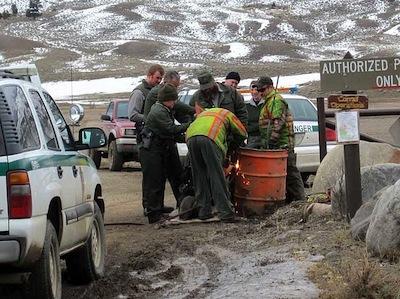
The winter bison reduction at Yellowstone has ended, but not before authorities neeed the help of a welder to remove a protester. Buffalo Field Campaign photo.
The annual reduction of bison from Yellowstone National Park has ended, with an estimated 600 of the iconic animals removed from the park's herds via hunting or culling.
The reduction brought the park's bison population down to about 4,000, which is considered a reasonable number by those who calculate such numbers. Whether more will die later this spring when they don't retreat back into the national park from their seasonal wintering grounds outside Yellowstone quickly enough for Montana ranchers remains to be seen. Part of the concern around the park's bison population stems from brucellosis, a disease that can cause cattle to abort their fetuses.
The 600 or so killed in the past few weeks have been "harvested" either by state and tribal hunters or "culled directly through capture and consignment to slaughter or research."
"This year half of the removal was conducted through capture and consignment from the Stephens Creek capture facility in Yellowstone National Park," park officials noted in a release. "As of Monday, March 3, state and tribal permitted hunting outside the park boundary in Montana had removed 199 bison from the north boundary area and an additional 64 bison from the west boundary area.
"The National Park Service has concluded bison population management operations at the Stephens Creek facility after consigning 258 bison to tribal partners for nutritional and cultural purposes and transferring 60 bison to UDSA-APHIS for an ongoing research project."
Still, the 4,000 or so bison remaining in the park's herds might nevertheless be too many, possibly by as many as 1,000, for those who oversee bison management. Back in 2000 the U.S. secretaries of Agriculture and Interior and the governor of Montana signed a court-mediated agreement that included guidelines to limit the bison population in Yellowstone to around 3,000 to 3,500 animals.
The cooperating agencies operating under the Interagency Bison Management Plan are the National Park Service, the U.S. Forest Service, the Animal and Plant Health Inspection Service, the Montana Department of Livestock, the Montana Department of Fish, Wildlife and Parks, the InterTribal Buffalo Council, the Confederated Salish Kootenai Tribes, and the Nez Perce Tribe.
The annual bison hunt/culling always is controversial. The Buffalo Field Campaign long has worked to end, or at least impede, the reductions. Last Thursday one activist blocked truck traffic at the Stephens Creek capture facility for about two hours by sitting down in the road. The man, Comfrey Jacobs, chained himself to a 55-gallon drum filled with concrete.
At one point authorities tried to use a front-end loader to move him out of the way, and finally brought in a welder to cut his chains. In the end he was arrested for disorderly conduct and interferring with a government operation, according to the Buffalo Field Campaign.



Add comment